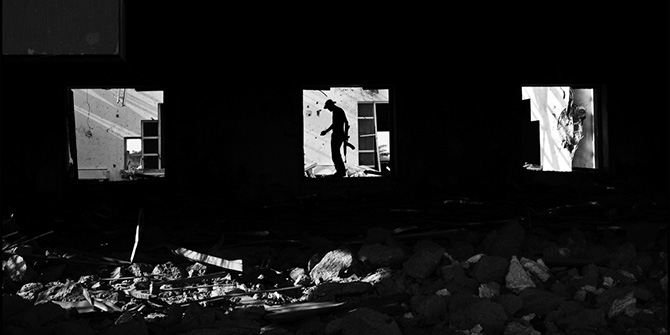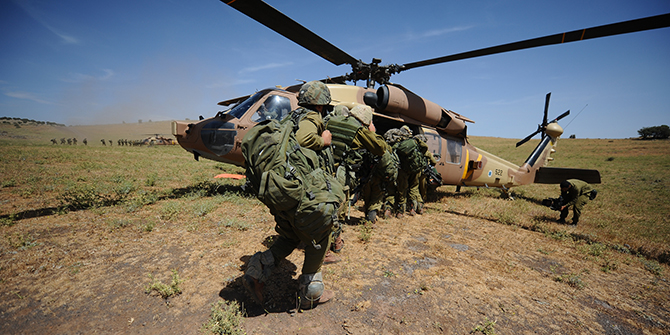by Karen E. Young
There is an allegory now circulating among Gulf analysts: Two trains left the station at the same time, one from Abu Dhabi and one from Doha. In Libya they collide, and no one is there to assess or reconstruct the damage.*

Early warning systems of state failure and collapse were novel approaches to bring political science and foreign policy communities together in the late 1990s and early 2000s. This effort created task forces and intelligence projects generating complex data sets and rich empirical studies of countries in, and emerging from, civil war and failed governance. The subsequent research predicted an increased likelihood of internal violence when states exhibit ethnic heterogeneity, political grievance, and are located in a region or neighbourhood of conflict. Economic underdevelopment and inequality are better indicators of the onset of revolutionary or non-identity wars.The research also pointed to the internal, often economic, logic of civil wars. Both greed and grievance will prolong conflicts and serve to reignite them even after peace is reached. Civil wars ignite localised grievances, giving people opportunities for retribution for unrelated, often personal, conflicts. Natural resources provide fungible assets to prolong conflict and enrich fighters. Perhaps what we didn’t correlate sufficiently was how simultaneous regional power competitions and systemic withdrawals, or lack of political will from the international community to intervene, might also contribute to state collapse.
Intervention is the new foreign policy of the leading Gulf Cooperation Council states, though often these respective foreign policies are in contradiction, or supporting opposing sides of regional conflicts. The causes of this emerging interventionism are multiple and diverse across the UAE, Qatar and to a lesser extent, Saudi Arabia. All Gulf States have tripled their military expenditure since 2003. The relationship between GCC states remains relevant, as these states share a sense of identity, with competing narratives of development and historical legacy. To generalise, the Omanis have a sense of lost empire, while the Qataris and Emiratis are often viewed as invented or derivative national projects by their Saudi, Yemeni and Omani neighbours. Gulf states define themselves in relation to the history and current trajectory of their neighbours. Diplomatic slights are mechanisms to keep score in a long-standing practice of tribal competition morphed into state building.
In The Political Economy of Energy, Finance and Security in the United Arab Emirates: Between the Majilis and the Market, I argue that the UAE and Qatar have been able to interject themselves at the regional level because of at least four factors: commodity price booms from 2009-2014 generating state income, a new generation of leadership emerging after 2005 with a view to build prestige and recognition, massive arms purchasing programs facilitated by the United States and the West, and a regional power shift or vacuum after the wars in Iraq, and after 2011, the revolution and upheaval of Egypt as home to a larger pan-Arab political centre.
Libya is one current site of this intervention. Qatar has supported Tripoli-based Libya Dawn, affiliated with the Islamist-led General National Congress. The UAE supports General Haftar and his Operation Dignity, allied with the rival government, the House of Representatives, based in Tobruk. Egypt, with at least nominal UAE support, has targeted rebel groups associated with Islamist factions.

Libya is on the verge of a humanitarian disaster. A porous border, refugee crisis (also affecting Tunisia), and roving bands of militias threaten Egypt, along with the UAE’s political and financial investment there. The Political Isolation Law, a draconian attempt to collectively punish those associated with the Gaddafi regime, affects an estimated one in four Libyans, with nearly 10 per cent of head of households unemployable. Libya’s oil production has dipped below 200,000 barrels a day, certainly no calamity to Gulf oil producers.
Saudi Arabia and the UAE have two existential threats. One is Iran, which they fear as an alternative source of political ideology, both in its revolutionary status and its ability (regardless of its efficacy) to bridge Islamic identity and representative governance, and as a competing economic model with its better educated population and more diversified economy. The second is the upheaval of the existing political order – tribal monarchy. Externalising these threats as political Islam and a technologically advanced and more integrated Iranian economy (with nuclear energy), the foreign policies of KSA and the UAE are prepared to counter these threats with military action.
The manipulation of political Islam as a transnational enemy is a convenient tool for authoritarian states in the Gulf to persecute internal dissent and to link neighbouring conflicts to national security. Islamic State and its proliferation, whether it is ideologically driven by Salafist interpretations of Sunni Islam (grievance), or economically predatory as terrorist gangs or warlords (greed), fits into the Gulf Arab state security paradigm as both a threat to regime survival and, often a way to counter any concurrent foreign policy intervention by Iran. In short, both the Arab Gulf states and Iran use flare ups of localised, sometimes sectarian, conflict to settle their own disputes.
Qatar is caught holding the metaphorical bag of pan-Arab freedom fighting, with its support for what it sees as locally-supported political movements with the potential for delivering effective governance. Its efforts at an open door policy towards many stripes of political organisations in the region have been labeled as support for terrorism in Egypt, in Libya and inside the Gulf. This is a policy neighbouring Saudi Arabia and UAE cannot tolerate, though they offer no alternative dialogue or distinction between moderate Islamist political groups and Salafist warlords.
Troubling is that the intervention in Libya is probably act one of a three act play. Yemen is likely to be next; even peaceful Oman could follow. Yemen’s political dysfunction is not new. Its sources of political organisation fall on sectarian lines, but this difference is not the root cause of the conflict. Its economy is in free fall, its natural resources (including water) are nearly exhausted, and its young population has little opportunity for education and mobility. GCC states are more coordinated on Yemen, mostly in deference to Saudi Arabia’s historical claim as arbiter in Yemeni conflict, though there is little momentum for reconciliation or dialogue. Instead, Saudi Arabia uses a familiar rhetoric linking Iranian interference with increasing sectarian violence.

Oman’s succession plan is idiosyncratic. After Sultan Qaboos dies, the senior members of his family, a Royal Family Council, will meet to elect a new leader by consensus, likely one of three cousins of the Sultan who meets the current inheritance standard. (Only Muslim male descendants of Qaboos’ great-great-grandfather Sultan Turki (r. 1871-88) with Omani Muslim parents are eligible to become sultan.) If the Council fails to reach consensus, there is the “secret envelope” with the name of the current Sultan’s top two preferences for his successor inside. Of course, where this envelope is and who will see it, and if it matches the consensus candidate, are murky details.
Besides a looming power vacuum in a highly personalised state apparatus, the more troubling element in Oman in the near future is that the country is more and more distanced from its GCC partners, in part because of rising sectarian preferences and politicisation of Islamic identity(ies) in the sub-region. The Sultan and the ruling family of Oman are of the Ibadi sect, a pre-Shi’a Islamic branch. Many Ibadis feel the Saudi position is dismissive of the legitimacy of their sect. Oman’s comfort with Iran, as a neighbour with full diplomatic ties (and its historical sectarian tolerance), is increasingly a source of tension within the GCC.
We know from the state failure literature and case experience in Africa that bad neighbourhoods make conflict more likely. Sectarian violence feeds on underlying and localised conflict, but it also attracts sympathisers who use the rhetoric to settle old scores in their own locales. Failed governance, economic inequality and poverty create social pressure for change. Add to this the regional power dimension in which Saudi Arabia, Qatar and the UAE cannot agree who is in charge, and an international community that wants nothing to do with ground combat in the region, we have a train wreck waiting to happen.
Karen E. Young is Research Fellow at the Middle East Centre at LSE. She was Assistant Professor of Political Science at the American University of Sharjah, UAE from 2009 to 2014. In 2013-14, she was an American Political Science Association MENA Fellow.
I am grateful to Florence Gaub for sharing this allegory, as part of the “Mapping GCC Foreign Policy: Resource, Recipients and Regional Effects” workshop in Doha, 22 February.






“This effort created task forces and intelligence projects generating complex data sets and rich empirical studies of countries …” I beg to differ: no, it did NOT. Had that been as you say, all the recent US-led interventions in e.g. Iraq, Afghanistan, Yugoslavia or Libya must not have happened. Any simple analyst with a map and a history book could have told you what would happen. In each and every case the very opposite of prudent conflict management can be observed. And if we take George Friedman’s (of STRATFOR repute) word for it, these were orchestrated “divide and conquer” operations. So, oh yes, after all,m maybe you ARE right and these data were put to use. But NOT in the way you suggest. So we should ask, IF we are impartial scientists: a) “what gives” and b) “cui bono”?